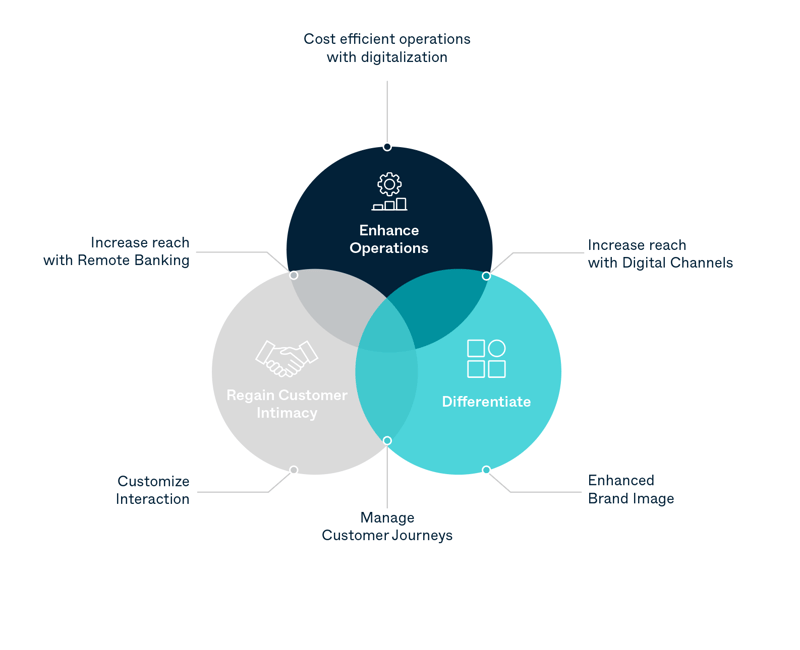While 2020 took us lightyears ahead in digital adoption, both by bank employees and customers, it’s important to remember that human connections are still the foundation of successful consumer banking. As we move forward, video meetings are not expected to decrease - in fact, they will likely only increase as banks become increasingly digital.
Merging digital ease with the “human touch”
But how do you maintain the feeling of an in-person, face-to-face interaction?
Choose the right video conferencing technology. This includes:
- An easy-to-use solution, that can be accessed via one click, regardless of what device your customer is using. With Pexip solutions, video meetings can be joined via a browser, without needing to download any apps or remember any PIN codes.

- Pexip’s AI-powered Adaptive Composition engine makes the video experience more natural, relaxed, and closer to in-person than ever before.

- According to a report from PWC, brand familiarity and digital capability are important differentiators, especially for millennials. Custom branding allows your organization to tailor the visuals of your “meeting room,” making customers feel more at ease, and trusting they’re in the right place.

- Pexip’s ultra-high quality audio and video helps make customer interactions clearer, allowing you to catch every nuance and make them feel seen, heard, and taken care of.
How retail banks can master customer engagement
Did you know?
- Only 10% of retail banks regularly work on enhancing the customer experience
- Yet over 70% of retail banks believe that digital customer engagement is important to the success of their businesses today and tomorrow
Customer engagement is essential in today's competitive landscape.
Get your free copy of our guide and learn how to win more customers and scale your business.
Where does video conferencing technology help best, and why should banks keep using it in the post-pandemic era?
1. Cutting costs and boosting revenue.
Running a branch office is expensive, accounting for half the operating costs of some banks according to McKinsey. Doing a combination of in-person and video meetings, both for internally and with customers, saves money on travel, office overhead costs, and employee expenses, along with operational costs such as recruitment.
One of our bank customers was able to use branch-based video services to help them reduce their specialist recruitment costs, while increasing the efficiency of existing specialist staff by 200% to 300%. In some instances, sales conversions increased over 23%. This was attributed to a high-value product line within the bank (mortgages), meaning that the significant growth led to higher revenues overall.
In the case of another customer, staff retention rates increased thanks to the introduction of optimized video solutions. This bank was experiencing employee turnover happening after approximately 18 months. Once specialists were given the option to take meetings virtually, the average turnover rate decreased significantly, with employees staying with the organization for approximately 36 months. A reduced employee turnover rate can result in lowered costs associated with onboarding and training, and more experienced employees are often in a better position to bring in higher revenue.
2. Improvement of customer interactions, both in frequency and quality.
Video meetings bring the bank, quite literally, into the customer’s home. During the pandemic, video solutions allowed for continuity of relationships in the immediate future, but this cultural shift doesn’t need to end once things return to “normal”.
Providing your customers with easier access to personalized, face-to-face consultations with your team means more of your services can be offered to a wider pool of customers, including those who may have had limitations to reaching your branch locations in the past, such as where they live, their lifestyle, or working hours. This kind of accessibility makes them feel seen and taken care of, while bringing more possibilities to you, such as sales nurturing and customer retention.
In addition, there are situations where the customer’s journey requires handoffs between specialists, which can be a simplified process when using video meetings. Using this technology to nurture existing relationships or build intimacy in new relationships allows for cross-selling, upselling, and customization to the individual consumer. They perceive it as better service, while for you and your team, it’s a more efficient workflow.
3. Market differentiation.
Putting your best face forward, even for cold calls, can help you and your organization be heard, remembered, and valued. Banks and other financial institutions have been becoming more digitally fluent and present for decades, and just offering online banking and virtual services isn’t enough to stand out in today’s tough competition.
Banks everywhere are fighting to be seen as the most innovative, and keeping customers engaged and loyal is tough. Customers are becoming more critical, and can choose to leave and try another bank for something as simple as an app’s bad user interface or a video chat that was too complicated to access.
Savvy end-customers and other consumers of your services also care more about security now than ever before. They want to know where and how their data is being stored, and whether confidential discussions about their personal finances are secure. Video is on the way to becoming an even more natural part of the customer interaction, but to build and maintain loyalty, it has to be done right.
How has Covid-19 shifted our perception of video communications?
Despite the many challenges faced by financial institutions and their customers throughout the Covid-19 pandemic, one thing has been made clear: that both time and money can be saved by holding video meetings instead of traveling to meet in-person, whether that’s taking an international flight to visit a corporate headquarters, or driving across town to a bank’s local branch.
While in 2018 one of my clients was aiming to host 50% of customer communications on a digital platform, in the Covid-19 context their goal is now approaching 100%. Why? First necessity, then convenience. Social distancing measures and corporate responsibility for customer safety meant that many financial institutions had to find new ways to continue operations and communicate with their customers.
For many, that meant incorporating video into their telebanking and online services, or, if they already offered video, vastly scaling up. While some bank customers may not have been comfortable with this technology, in the banking context or otherwise, there was an urgent necessity that pushed this learning curve into action, making adoption rates rise rapidly, even for the most unlikely users.
When thinking about video banking as a long-term solution for consumer banking, it’s helpful to think about it within the wider picture. What do banks need to do to be successful, and how can technology like video banking help them get there?
The graphic below illustrates a Macro/Micro view of challenges and priorities within the financial services industry when it comes to digitalization:

When used in the right way, video conferencing technology can help your financial organization boost revenue and efficiency, both in cost and operations, while retaining, and in some cases, regaining the customer intimacy that may have been lost during the past year.
As we move onto the next phase of virtual banking, it’s not enough to offer video solutions; you have to offer an experience that will make your customers keep choosing you.
Learn more about Pexip’s video conferencing solutions for financial services.
- Financial services
- Digital transformation
- Personalize customer engagement
- Engage
- Video Platform

-min-2.jpg?width=700&name=iStock-1214479802%20(1)-min-2.jpg)
.jpeg?width=41&name=Michael%20Whittam%20(1).jpeg)


